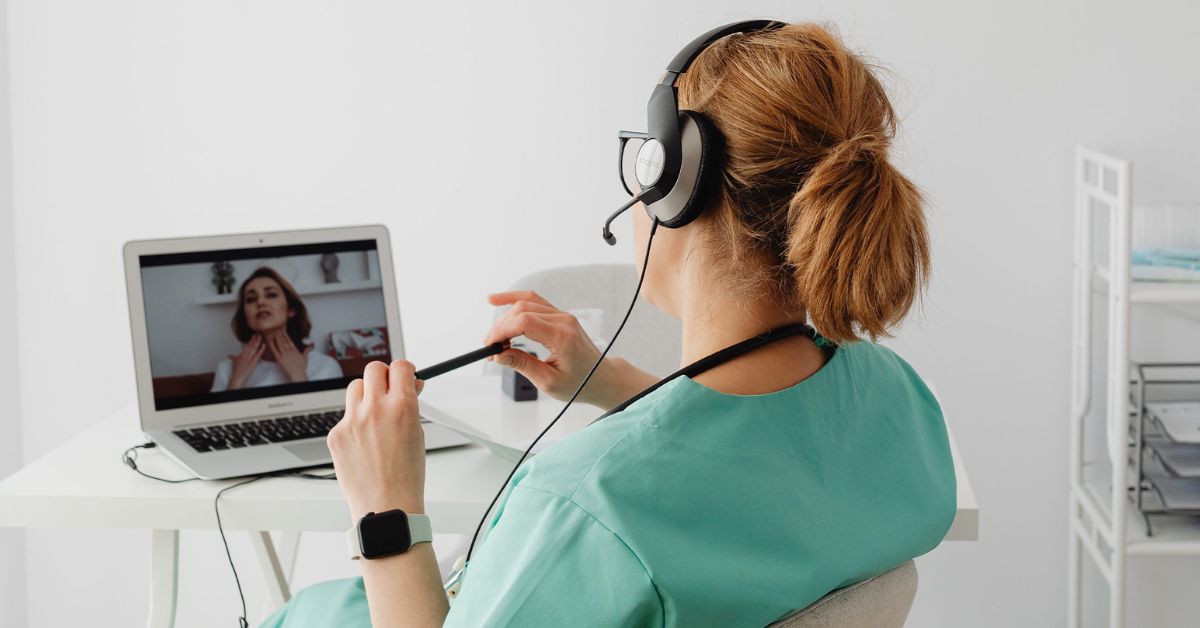Telehealth nursing has emerged as a transformative force in healthcare, redefining how patient care is delivered and experienced. Over the past decade, rapid advances in technology have enabled nurses to extend their expertise far beyond the traditional confines of hospitals and clinics.
In this article, we explore how telehealth nursing is revolutionizing patient interaction, discussing its evolution, benefits, challenges, and future potential. We also examine how this model of care not only improves access to healthcare but also enhances the overall quality of patient outcomes.
In This Article
The Evolution of Telehealth Nursing
Historically, nursing was predominantly practiced in person, with care delivered face-to-face in hospitals, clinics, and patients’ homes. However, as technology advanced, healthcare providers began exploring remote care options. Telehealth nursing initially focused on simple tasks like phone consultations and remote monitoring of vital signs. Over time, however, it has evolved into a sophisticated, technology-driven practice that leverages video conferencing, mobile apps, electronic health records (EHRs), and wearable devices.
Early Adoption and Growth
The early 2000s witnessed the first attempts at remote patient monitoring, especially in rural areas where access to healthcare was limited. Nurses played a pivotal role in managing chronic conditions through phone calls and home visits. As broadband internet became more accessible and smartphones emerged, telehealth expanded to include real-time video consultations. This allowed nurses to visually assess patients, provide health education, and offer immediate support during emergencies.
The Catalyst: COVID-19 Pandemic
The COVID-19 pandemic served as a major catalyst for telehealth nursing. With social distancing measures in place and in-person visits drastically reduced, healthcare systems worldwide rapidly adopted telehealth solutions. Nurses were at the forefront of this shift, conducting virtual consultations, monitoring patients with COVID-19 symptoms remotely, and managing chronic conditions without exposing vulnerable populations to unnecessary risks. The pandemic demonstrated that remote care could not only maintain continuity of care during a crisis but also improve efficiency and patient satisfaction.
How Telehealth Nursing Works?
Telehealth nursing integrates various technological tools to facilitate remote care. Here’s an overview of how telehealth nursing operates:
Virtual Consultations and Assessments
One of the most significant aspects of telehealth nursing is virtual consultations. Using video conferencing platforms, nurses can connect with patients in real time, conduct visual assessments, and discuss symptoms, treatment plans, and follow-up care. These interactions are often as thorough as in-person visits, with nurses able to observe non-verbal cues and assess the patient’s overall condition.
Remote Monitoring
Remote patient monitoring (RPM) is another critical component. Patients use wearable devices and home-based monitoring tools (such as blood pressure monitors, glucometers, and pulse oximeters) to track vital signs and other health metrics. These devices transmit data directly to healthcare providers, allowing nurses to monitor chronic conditions such as diabetes, hypertension, and heart disease. Alerts can be set up for abnormal readings, enabling prompt intervention.
Integration with Electronic Health Records
Telehealth systems are closely integrated with EHRs, ensuring that all patient data is accessible in one place. This integration facilitates seamless communication between telehealth nurses and other healthcare providers. It also helps maintain accurate and up-to-date patient records, ensuring continuity of care even when patients move between virtual and in-person settings.
Health Education and Counseling
Beyond clinical assessments, telehealth nursing offers an excellent platform for health education. Nurses can provide patients with tailored advice on managing chronic conditions, medication adherence, lifestyle modifications, and preventive care. Virtual sessions allow nurses to share educational materials, demonstrate techniques (such as proper inhaler use or wound care), and answer patient questions in real time.
Benefits of Telehealth Nursing
Telehealth nursing presents a range of benefits that are transforming the landscape of patient care:
Improved Access to Care
Telehealth nursing breaks down geographical barriers. Patients in remote or underserved areas can now access expert care without the need to travel long distances. This increased accessibility is particularly valuable for those with mobility issues, chronic illnesses, or limited transportation options.
Enhanced Patient Engagement
Remote care encourages patients to take a more active role in their health management. With regular virtual check-ins and continuous monitoring, patients become more aware of their health metrics and are more likely to adhere to treatment plans. This proactive engagement often leads to better health outcomes and a higher level of patient satisfaction.
Cost and Time Efficiency
Telehealth nursing reduces the need for in-person visits, saving both time and money for patients and healthcare providers. Reduced travel, shorter wait times, and fewer missed workdays contribute to overall cost savings. For healthcare systems, telehealth can streamline workflows, decrease hospital readmissions, and lower the cost of delivering care.
Enhanced Continuity of Care
With telehealth, care becomes more continuous and coordinated. Virtual visits enable timely follow-ups and regular monitoring of patients with chronic conditions. This continuity helps in early detection of potential issues and allows for prompt adjustments in treatment plans, ultimately leading to better health outcomes.
Flexibility and Convenience
Telehealth nursing offers unmatched flexibility. Patients can schedule virtual appointments at times that suit their busy schedules, and nurses can manage their caseloads more efficiently. This convenience extends to both patients and healthcare providers, reducing stress and improving overall satisfaction with the care process.
Increased Efficiency in Managing Chronic Diseases
For patients with chronic illnesses, regular monitoring is critical. Telehealth nursing enables continuous oversight without the need for frequent in-person visits. Nurses can track patients’ progress, adjust treatments promptly, and provide timely interventions if necessary. This proactive management of chronic diseases not only improves quality of life but also prevents complications and hospitalizations.
Challenges and Considerations
While telehealth nursing offers numerous advantages, it also comes with its own set of challenges:
Technology and Infrastructure Barriers
Effective telehealth nursing depends on reliable technology and robust infrastructure. In areas with limited internet connectivity or among populations with low technological literacy, implementing telehealth can be challenging. Healthcare providers must invest in user-friendly platforms and provide support to patients who may struggle with the technology.
Privacy and Security Concerns
Handling sensitive patient data over digital platforms raises concerns about privacy and cybersecurity. Ensuring that telehealth systems comply with data protection regulations (such as HIPAA in the United States) is paramount. Healthcare organizations must implement stringent security measures to protect patient information and maintain trust.
Regulatory and Reimbursement Issues
The rapid expansion of telehealth has sometimes outpaced existing regulations and reimbursement models. Policies regarding telehealth licensing, interstate care, and insurance coverage can vary widely. Navigating these regulatory challenges is crucial for ensuring that telehealth nursing is sustainable and accessible to all patients.
Maintaining the Human Touch
One of the biggest challenges for telehealth nursing is preserving the personal, human element of care. While virtual interactions can be effective, some patients may feel that the absence of physical presence detracts from the quality of care. Training telehealth nurses to communicate effectively, build rapport, and convey empathy through digital channels is essential for overcoming this barrier.
Integration with Traditional Care
Successfully integrating telehealth nursing with traditional in-person care requires careful coordination. Healthcare providers must develop protocols that ensure seamless transitions between virtual and face-to-face interactions. This integration is critical for maintaining continuity of care and ensuring that patients receive the most appropriate treatment for their needs.
The Future of Telehealth Nursing
As technology continues to evolve, the future of telehealth nursing looks promising. Here are some key trends and innovations that are likely to shape the future of remote care:
Artificial Intelligence and Predictive Analytics
Advancements in artificial intelligence (AI) and machine learning are set to revolutionize telehealth nursing. AI-powered systems can analyze vast amounts of patient data, identify patterns, and predict potential health issues before they become critical. This proactive approach can help nurses intervene early, personalize treatment plans, and improve patient outcomes.
Expanded Use of Wearable Technology
Wearable devices are becoming increasingly sophisticated, with the ability to monitor a wide range of health metrics in real time. As these devices become more integrated with telehealth platforms, nurses will have access to continuous, accurate data that can inform clinical decisions and optimize care management.
Enhanced Virtual Reality and Augmented Reality Tools
Virtual reality (VR) and augmented reality (AR) have the potential to transform patient education and remote care. For example, AR can be used to guide patients through self-care procedures, while VR can provide immersive training experiences for nurses. These technologies could further enhance the effectiveness of telehealth nursing by providing interactive, engaging ways to deliver care and education.
Greater Interoperability and Data Integration
Efforts to improve interoperability between different healthcare systems and digital platforms will enhance the efficiency of telehealth nursing. Seamless data integration across EHRs, remote monitoring devices, and telehealth platforms will enable a more comprehensive view of a patient’s health, facilitating better-informed decisions and coordinated care.
Personalized and Precision Medicine
As personalized medicine continues to gain traction, telehealth nursing will play a crucial role in delivering tailored care. With access to detailed patient data and predictive analytics, nurses can customize interventions to meet the unique needs of each patient. This personalized approach can lead to improved outcomes, reduced hospitalizations, and a higher level of patient satisfaction.
Case Studies: Success Stories in Telehealth Nursing
Numerous healthcare organizations have already embraced telehealth nursing with promising results. Consider the following examples:
Rural Healthcare Access
In rural areas where access to specialized care is limited, telehealth nursing has been a game changer. One healthcare system implemented a telehealth program that connected rural patients with urban specialists. Nurses played a central role in coordinating virtual consultations, monitoring chronic conditions, and providing patient education. The result was a significant reduction in hospital readmissions and an overall improvement in patient outcomes.
Chronic Disease Management
A large healthcare provider integrated telehealth nursing into its chronic disease management program. Patients with diabetes and hypertension used wearable devices to monitor their vital signs, and nurses conducted regular virtual check-ins. This proactive approach led to better glycemic control, fewer emergency room visits, and enhanced patient satisfaction. The program highlighted how continuous remote monitoring and timely interventions can lead to long-term improvements in health.
Post-Discharge Care
Telehealth nursing has also proven effective in managing post-discharge care. Hospitals have implemented virtual follow-up visits to monitor patients after surgery or acute care episodes. Nurses assess recovery progress, manage pain, and provide guidance on wound care and medication adherence. These virtual visits have resulted in reduced readmission rates and a smoother transition from hospital to home, illustrating the potential of telehealth nursing to enhance continuity of care.
Also Read:
- From CNAs to RNs: Career Advancement Opportunities in Nursing and Job Growth Prospects
- The Role of Technology in Nursing Job Growth: Emerging Trends and Opportunities
- Diversifying the Nursing Workforce: Strategies for Increasing Diversity and Inclusion
Conclusion:
Telehealth nursing is revolutionizing patient interaction by extending the reach of quality care beyond traditional settings. By leveraging technology, telehealth nurses can provide timely, personalized, and efficient care that improves health outcomes and patient satisfaction. From virtual consultations and remote monitoring to the integration of advanced technologies like AI and wearables, the evolution of telehealth nursing represents a significant shift in the way healthcare is delivered.
The benefits of this model—improved access to care, enhanced patient engagement, cost efficiency, and the potential for early intervention—are driving widespread adoption across the globe. However, challenges such as technology barriers, privacy concerns, regulatory complexities, and the need to maintain a personal touch remain. Addressing these challenges will be critical as telehealth nursing continues to evolve and expand.
Looking ahead, innovations in technology and data integration promise to further enhance the effectiveness of telehealth nursing. As healthcare systems invest in new tools and training, telehealth nurses will be better equipped to deliver high-quality care that is both personalized and proactive. Ultimately, the future of telehealth nursing is bright, offering a pathway to a more accessible, efficient, and patient-centered healthcare system.
For patients, healthcare providers, and policymakers alike, embracing telehealth nursing means recognizing its transformative potential and working collaboratively to overcome its challenges. With continued innovation and commitment to quality care, remote nursing will remain a cornerstone of modern healthcare, ensuring that patients receive the right care at the right time—no matter where they are.
In summary, telehealth nursing is not just a temporary solution or a response to the challenges posed by events like the COVID-19 pandemic; it is a sustainable model that is here to stay. By revolutionizing patient interaction and bridging the gap between technology and compassionate care, telehealth nursing is paving the way for a future where quality healthcare is accessible to all.







